|
|
Review of GSM-smartphone Nokia E50
Live photos of Nokia E50
Sales package:
- Smartphone
- Li-Ion 970 mAh battery (BL-5C)
- Charger
- USB-cable
- User Guide
- CD with software
- Mono-headset
- Charger adapter
Nokia E50 was introduced in summer, 2006 as an addition to the enterprise line-up going by the name of Eseries, the announcement itself went without any needless fuss, though, and against all gossips and expectations, the E50 came alone back then without being accompanied by two other Eseries-branded devices, meaning that the company’s tradition to unveil three offerings at a time, like it had done it at Nseries conferences, was broken.
Back then, neither the handset’s design, nor its functionality generated much of a stir – a few can be blown away nowadays with a 1.3 Mpix camera and a 2-inch big QVGA display. Bluntly speaking, there was no “flavor” in this offering, nothing that would have drawn the crowd’s attention.

Here I would like to devote a couple of words to the very philosophy of the Eseries line-up in general – why it was established, what are its prerequisites for further development and what the future holds for it. The niche of enterprise-smartphones and communicators has been around for quite a while, but was filled up with proposals based off Windows Mobile, mainly HTC-branded solutions and Research In Motion (RIM) very own Blackberry. Devices running Symbian operating system didn’t have any solid representation till the 2Q of 2006. Back in the days of first Eseries models release (9300/9500 never made it to “mass products” category) the situation got turned over. There was something good about them, something bad as well, but they fulfilled the mission they were endowed with and secured initial loyalty of consumers, even though their sale rates (except for the E70, the most highly tailored device) are still revolving around pretty low, yet stable figures. The pricing policy applied to these handsets may be described with this: enterprise solutions at affordable price. Once three pioneers have hit the market, it is about time to come up with another model that should become the range’s best selling device owing to several reasons we will be breaking down below.
Summing everything up for Eseries, I would like to say that competition within the company’s range is minimal – after all, the gap separating Eseries and Nseries positioning-wise is considerable, at the same time Nseries devices are placed higher in the Nokia’s charts, have not-so-long lifecycle and more frequent announcements of newcomers to the line-up.
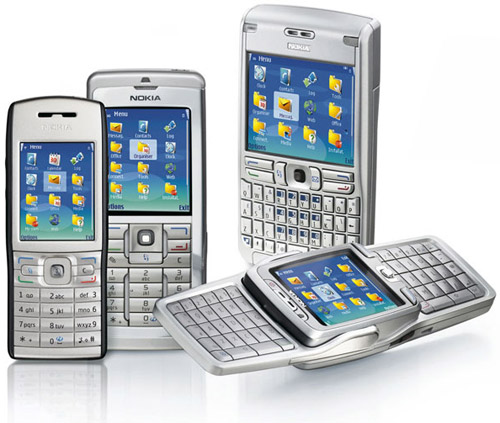
Having done away with this little digression, we are getting back to the E50. What new does it bring to the table and what its trumps in the competition are?

Our forum saw some intriguing debates on so called the line of succession between the iconic Nokia 6310i and the E50. Honestly, I had pretty much the same thoughts mostly due to the following reasons: similar positioning of the devices (both are aimed at business-users); akin dimensions (with the bottom getting thinner, which allows both phone to fit in hands nicely); missing camera (E50-2) and finally, not the least of the factors, battery life. The last point we mentioned can be barely called “similar” for these handsets, but still, among smartphones, the E50 is one of the longest lasting offerings.
To me, what didn’t happed with the 6230 and the E60 that were dubbed as the successors to the 6310i, has finally become a reality with the advent of E50 – the handset got an inheritor that fits the needs of the 6310i’s audience in terms of both looks and positioning, and suite of features. While these models’ designs prove to be resembling to some extent, there is no way we could call them “similar” – it is all about the feeling itself here.
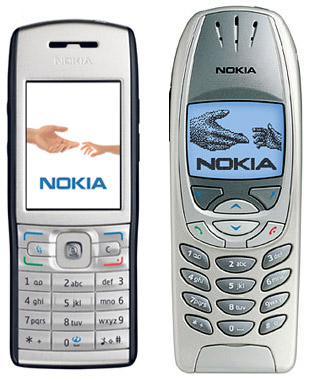
Model E50 is rivaled, though strange it might sound, by a handset made by Nokia itself, specifically Nokia 6233 – you will surely notice a ton of similarities between them should you take the position of an ordinary consumer, including dimensions- and display-related ones (the E50 is a tad thinner and taller). But the 6233 is much more multimedia-heavy, packing a 2 Mpix camera with VGA video recording and stereo-speakers at a lower price, though. Maybe this is the reason why the gap between the sale rates of these models is gigantic – the 6233 is thirty times more demanded.

Now onto the handset itself. Nokia E50 utilizes the candy-bar form-factor with the external antenna being shaved off and is positioned as the most portable Eseries smartphone (113x43.5x15.5 mm). Nokia, as always, is as honest about dimensions of its offerings, as only possible, so that 15.5 mm is the utmost limit of thickness on this handset, while the bottom part is a tad slimmer, measuring up at about 12 mm. Thus the E50 turns out to be the Finnish manufacturer’s slimmest smartphone around, and one of its range’s thinnest offerings.


The handset’s casing is made of high-grade (so it feels) black plastic with the edging on the sides varying from white glossy plastic or black, perfectly matching the sides’ color scheme. The battery cover is made of metal, just like the framings on the face around the display and beneath the keypad are. So markets will soon see third trim - Metal black, which comes in sole black.
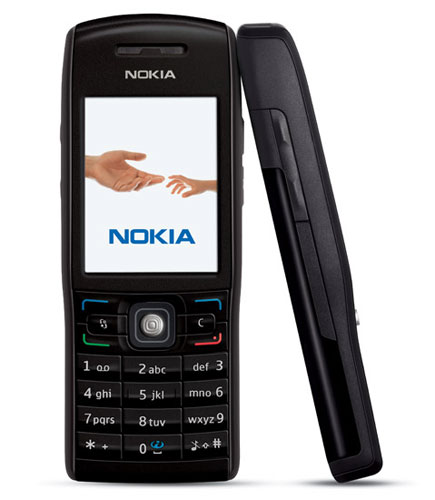
The only complaint about the build quality of the E50 and the materials used – the phone’s top end, specifically the power button doubling as a profile switcher. It utilizes pretty soft type of rubber that easily draws scratches from your nails and on top of that once pressed the button gets back to its initial position in a somewhat sluggish way, so that after some time you might encounter a sticky button problem.
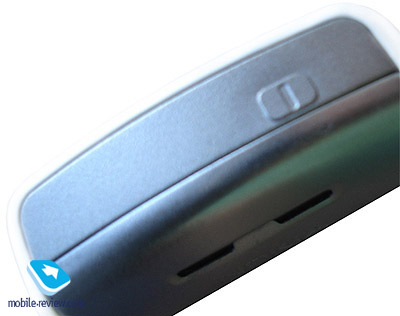
Apart from this, the E50 is clear of gripes – actually it is one of the few Nokia’s devices released lately that doesn’t creak, has all details finely attuned, as well as the battery cover firmly fixed – don’t tell us there is a gap, as it is the most improbable thing we have ever heard thank to the material used and a tight latch.
The keypad is made of metal-look-alike plastic. The keys offer you good tactile feelings and are big enough in spite of the E50 being quite tiny width-wise. Dedicated buttons “Menu” and “C” are, bluntly speaking, squeezed into the set of function keys, so due to sporting minor size, they might cause a couple or more accident presses. The E50’s joystick is small and very tough, meaning that this handset is more likely to go missing on the short-lists of gamers. The joystick’s design is totally opposite to what we see on Sony Ericsson-branded devices, in other words you can’t manage it by holding your finger pad on its top – on the contrary, it has to be in motion, lean it at certain angles. We won’t make any judgments here, but insted will strongly recommend to play around with the joystick on the E50 a bit more before going for this phone.
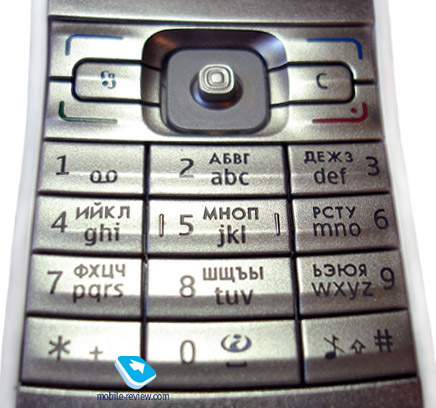
The light indicator can be hardly called a novelty (don’t confuse it with ambient light sensor) – we have already seen it with such Nokia’s products as the E61, N80, but in the E50’s case it circles the joystick. The indicator’s color cannot be changed, though – it is always green, and starts flashing, once one of the four events (found in the settings) has taken place. This approach is fetching, indeed and in future we would really like to see expansions of the indicators usability – more triggers, various colors, but this might be something superfluous for an enterprise-solution.
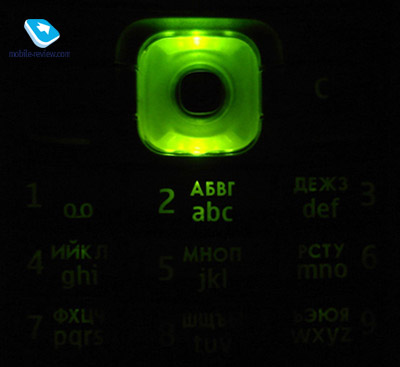
All keys are lit in blue – while the numberpad has even backlighting, the function keys are a bit out of focus, while hand up key has no lights coming from beneath at all.
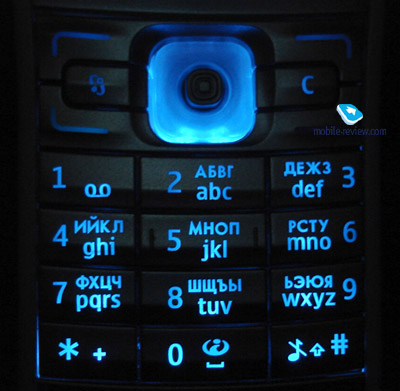
Already familiar to you “Pencil” key was moved to the right side of the handset, which makes more sense than Nokia’s N91 side-mounted menu button – press rates are incomparable in my opinion. Next to the “Pencil” is dedicated contacts/voice functions button (running a few steps forward I want to note that voice tags recognition boasts high quality of implementation – errors are rare guests here). But we were really disappointed to find out that this button can be assigned to no other application. On the left you will find volume rocker switch, nothing special about it. Ambient light sensor present on senior models is missing on the E50, so that expect the backlighting to turn on during daylight as well.
Overall, the keypad feels very good – we have no real gripes with it, everything lives up to the maker’s name.
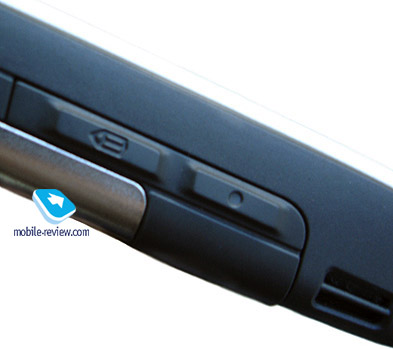
The display is topped by a grill-covered earpiece, whose volume is just enough for most situations. The bottom end is occupied by interface socket Pop-Port and the now standard slim charger clot. Removing the battery cover reveals hot swap-enabled microSD memory expansion slot. The battery coming included with the E50 is Li-Ion 970 mAh (BL-5C) unit. As the manufacturer claims, it can keep the handset up and running up to 9 days in standby mode and 6.8 hours in talk mode. You should bear it in mind though, that these figures can be achieved only in ideal conditions and will never end up at the user’s disposal.

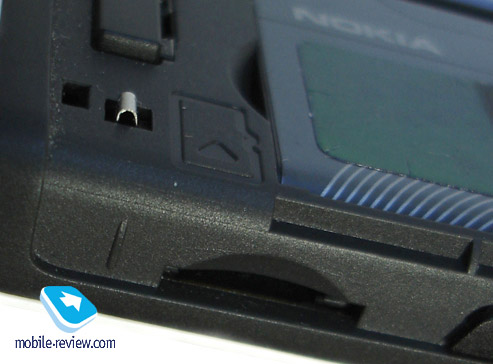
On average load (about 30 minutes of web surfing, 15-20 snaps, 1,5 hours of calls and a pair of SMS messages), the handset lasted two days, which is not bad at all for a smartphone. Should you be easier on its phone functionality and get your talk time to 30 minutes, the E50 will put up a bit more than 3 days of operation. You can also turn your sight to a more capacious battery BL-6C (1100 mAh), but for that you will need a special battery cover or have to remove the cover found inside the default cover. With the BL-6C, as its owners say, Nokia E50 stays alive for about 4 days on comparable load. It takes the phone about two hours to charge up from empty to full.

Nokia E50’s display measures 2.0” diagonally, and looks smaller than the rest of the Nokia-branded smartphones’ screens because of being narrower, whereas the height is equal. This display boasts QVGA resolution (240x320 pixels), making the picture smooth and almost free of pixel grid. Colors are vivid, at maximum brightness level your eyes will hurt, so be ware – the finest value, as I see it, is 70 percent for the screen’s brightness. According to Nokia the display shows up to 262 K colors, which is not as big as the senior models’ figures are. However you might even not notice this difference – they all have more than just satisfactory displays. The E50 behaves in the sun in the same way other Nokia’s smartphones do, but due to tiny size the E50’s screen falls short of, for example, Nokia N73, but this doesn’t make all the difference.

At such physical screen size, tiny fonts are always a pain – occasionally you will have to peer at the display to make out what is written on it.
Handset’s highlights
Smartphone Nokia E50 is a typical S60 3rd edition-based device, so we have nothing to do but redirect you to dedicated articles on the features of Eseries handsets and standard functionality of the platform.
Compared to the software Nokia Eseries smartphones come pre-installed with, this very phone lacks office documents editing ability – viewing only. Even though you can seamlessly deal with it by installing, for example, Office Suite, many just don’t get it why the company would need to bring about such restrictions. Screen rotation is also unavailable on the menu.
One of the major highlights of the E50, distinguishing it from other Eseries-branded offerings, as well as Nokia’s smartphones, is the revamped active standby mode, packing even more functionality and ease-of-use. The modifications are as follows: now the standby mode settings contain a list featuring those functions, whose notifications may be taken to the display. At a glance, there is nothing very special about it, but still it does make some difference. You are also at liberty to leave only shortcuts on the desk, without any notes.
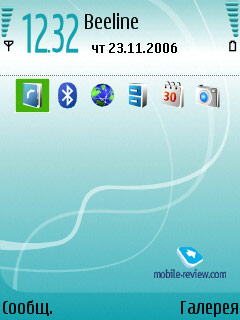 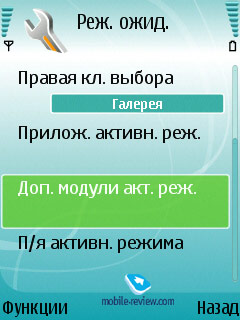
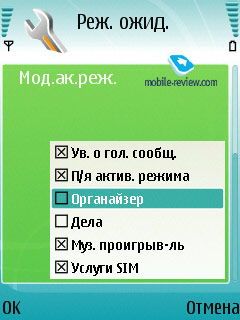 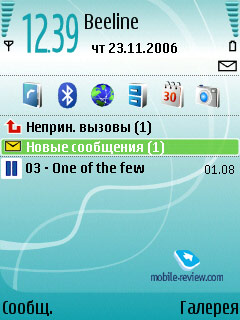
Another novelty, which is quite handy among all other things, is “Search application” – the way it works can be seen on the screenshots. As long as you have the search line unfilled, the app will return you information on amount of messages, contacts, calendar events, notes, tasks and other files. With the release of the E50 this applications made it to the mass market meaning that it is now available for other S60 3rd edition powered smartphones for no fee.
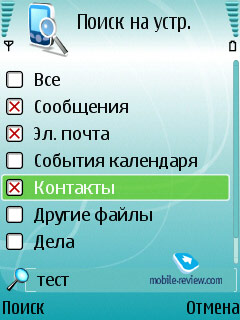 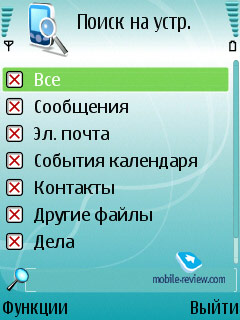
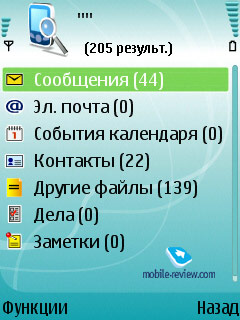
Extra applications include Adobe PDF, Zip (handles corresponding archives) and “Read messages”, which presents you with the functionality its name implies. By the way, text is read out quite legibly.
The device also fits for music playback – sound quality achieved with the help of AD-41 or AD-46 adapter and good headphones proves to be reasonable and falls only marginally short of, for example, the N73. The way the music player’s interface is laid out is nothing new compared to other Nokia-labeled handsets, lacking music-heavy positioning.
Other differences from the rest of Eseries include missing Wi-Fi and 3G/UMTS, which makes the E50 the only handset in the range (saving for the E62, tailored for the North American market) that can’t show off these functionalities. To some extent, the E50 steps onto the scene as a replacement for the E60, since it will take a while for us to wait for its true successor, and from this point of view, the fact that the senior solution is armed with features that have went missing on the E50 is quite a letdown.
The handset’s performance is about average, with the figures being more or less comparable with Nokia N73 – the gap is not something tremendous. To put it simply, the phone is pretty sluggish, which will repulse a part of potential buyers; nonetheless for most the difference in interface speed between the E50 and ordinary handsets won’t be that crucial. On top of that, the phone’s abilities partly make up for its being somewhat slow.
JBenchmark 1 |
JBenchmark 2 |
JBenchmark 3D |
Version |
1.1.1 |
|
|
Total Score: |
3359 |
|
|
Details: |
|
Text |
918 |
2D Shapes |
835 |
3D Shapes |
366 |
Fill Rate |
193 |
Animation |
1047 |
|
|
Screen Width |
240 |
Screen Height |
234 |
Color Screen |
true |
Number of Colors |
16777216 |
Double Buffer |
true |
Total Memory |
819200 |
Free Memory |
397588 |
|
|
MicroEdition Configuration |
CLDC-1.1 |
MicroEdition Profiles: |
MIDP-2.0 |
Microedition Platform: |
Nokia Å50-1/06.27.1.0 |
Microedition Encoding: |
ISO-8859-1 |
Microedition Locale |
ru |
|
Version |
2.0.1 |
|
|
Total Score: |
297 |
|
|
Details: |
|
Image Manipulation |
244 |
Text |
340 |
Sprites |
341 |
3D Transform |
558 |
User Interface |
144 |
|
|
Screen (canvas) Width |
240 |
Screen (canvas) Height |
234 |
Color Screen |
true |
Number of Colors |
16777216 |
JPEG Support |
true |
Transparency (Alpha Level) |
256 |
Double Buffer |
true |
Total Memory |
819200 |
Free Memory |
398284 |
|
|
MicroEdition Configuration |
CLDC-1.1 |
MicroEdition Profiles: |
MIDP 2.0 |
Microedition Platform: |
Nokia Å50-1/06.27.1.0 |
Microedition Encoding: |
ISO-8859-1 |
Microedition Locale |
ru |
|
Perfomance |
|
Jbenchmark3D HQ: |
123 |
Jbenchmark3D LQ: |
228 |
Triangles ps: |
38469 |
kTexes ps: |
1295 |
|
|
Version: |
3.1.0 |
|
|
Screen(canvas)width: |
240 |
Screen(canvas)height: |
320 |
|
|
3D Subsystem: |
|
M3G Version: |
1.0 |
Antialaising: |
false |
True color: |
false |
Dithering: |
false |
Mipmapping: |
true |
Perspective correction: |
true |
Local camera lighting: |
false |
Max lights: |
8 |
Max Viewport dimensions: |
1024 |
Max Texture Dimensions: |
256 |
Max Sprite Crop Dimensions: |
256 |
Max Transforms Per Vertex: |
4 |
Number of Texture Units: |
2 |
|
|
Other properties |
|
Color Screen |
true |
Number of colors |
16777216 |
Transparency (alpha level) |
256 |
Double buffer |
true |
Total memory: |
819200 |
Free memory: |
301560 |
|
|
MicroEdition Configuration |
CLDC-1.1 |
MicroEdition Profiles: |
MIDP 2.0 |
Microedition Platform: |
Nokia Å50-1/06.27.1.0 |
Microedition Encoding: |
ISO-8859-1 |
Microedition Locale |
ru |
Microedition Communication ports: |
COM0, IR0, USB0, BT0- BT-63 |
Microedition Hostname: |
localhost |
|
Camera. Here we should make a note that in fact there are two editions of the handset – Nokia E50-1 and the E50-2, boasting a 1.3 Mpix camera onboard. The E50 is only second Eseries solution to feature a camera, as previously it was the E70 alone, nevertheless both resolution- and quality-wise the reviewed unit is inferior to the abovementioned senior model, which comes as no surprise, though. Another point of interest is that the upcoming Eseries announcement will bring three camera-equipped handsets along. The concept of a camera-less enterprise solution has already become a thing of the past, so that now it is the market that rules the roost. This doesn’t mean, however, that we are not going to see more of the camera-less models coming, apparently the best thing to do is release two editions, which would be milestones from the standpoint of positioning and sales, just like in Nokia E50’s case.

A flash and a self-portrait mirror are absent on the handset. While handling the E50’s camera you can witness a curious effect – when trying to snap the best shot playing around with the viewfinder, colors look somewhat unnatural and blurry, but once you hit the trigger, the picture literally gets a new life injected into it, as lines get sharp again. Whether it is an issue we should attribute to the firmware or our unit, or the way the camera works – we do not know.
All photos look splendid on the smartphone’s screen thanks to the display’s resolution and top-notch quality; however on-PC-screen experience is not so great, as the quality leaves much to be desired. The matrix utilized by the E50 is one of the cheapest out there, to say the least. Green tint of the lens indicates that it home company is Samsung.
Self-time function (10, 20, 30 seconds) is available with the E50, as well as night mode, multi shot and three overlays – black-and-white, negative, sepia. Speaking of the new things to the Eseries, we cannot overlook white balance settings (auto, sunny, lamplight, fluorescent light).
Below you can familiarize yourself with the quality of the snaps taken with the E50:
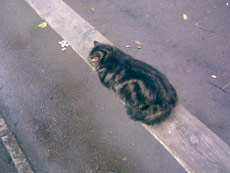 |
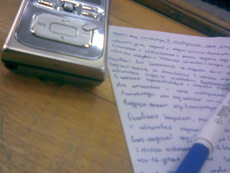 |
(+)
maximize, 1280õ960, JPEG |
(+)
maximize, 1280õ960, JPEG |
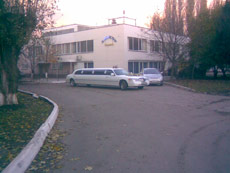 |
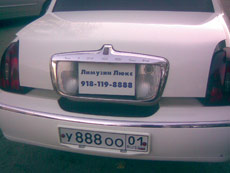 |
(+)
maximize, 1280õ960, JPEG |
(+)
maximize, 1280õ960, JPEG |
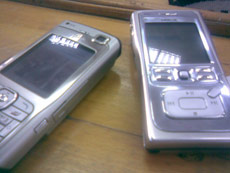 |
 |
(+)
maximize, 1280õ960, JPEG |
(+)
maximize, 1280õ960, JPEG |
 |
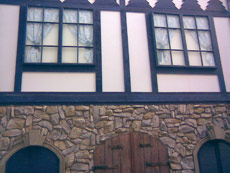 |
(+)
maximize, 1280õ960, JPEG |
(+)
maximize, 1280õ960, JPEG |
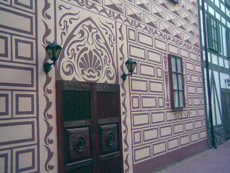 |
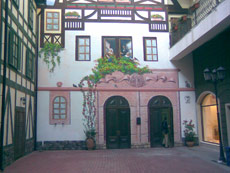 |
(+)
maximize, 1280õ960, JPEG |
(+)
maximize, 1280õ960, JPEG |
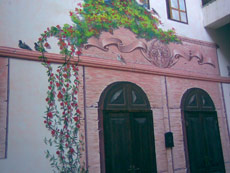 |
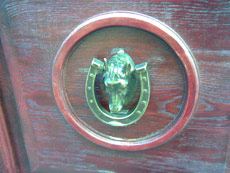 |
(+)
maximize, 1280õ960, JPEG |
(+)
maximize, 1280õ960, JPEG |
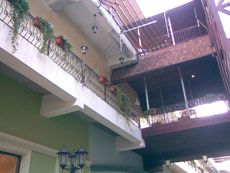 |
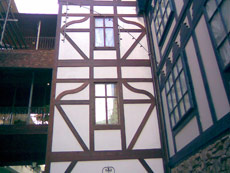 |
(+)
maximize, 1280õ960, JPEG |
(+)
maximize, 1280õ960, JPEG |
Video can be captured in two resolutions – 176x144 and 128x96 pixels. The quality is mediocre; however it is not camera or video recording what the E50 is all about.
Video sample (3gp, 300 Kb)>>>
Impressions
This handset has no problems in terms of network reception quality, sound in loudspeaker is pretty good, person whom you’re speaking to will hear you well. The silent alert is quite strong – be sure you will feel it in your jacket’s pocket. While the speaker is a bit different from what we saw on other Eseries-branded models, it outputs just enough of volume to not let you down in most situations.
Over the time I had the pleasure of using this device, I got an interesting feeling: while the E50 was so unsophisticated on the face of it, I had a really good time managing it. I can’t say what exactly made me think this way – maybe the nice feeling of metal employed in the casing and combined with slim and elegant design, maybe crisp display and handy keypad, or some other aspects – at the end of the day this doesn’t change the fact that I had almost no gripes with the handset’s operation. I don’t want to say the E50 has no shortcomings – the thing is, for its target audience they are minor.
This model can be recommended to people looking for a handy, slim and light handset packing good functionality. And this is what Nokia E50 is about.
Related links:
Anton Spiridonov (nl_pd@hotmail.com)
Translated by Oleg Kononosov (oleg.kononosov@mobile-review.com)
Published — 22 January 2007
Have something to add?! Write us... eldar@mobile-review.com
|
News:
[ 31-07 16:21 ]Sir Jony Ive: Apple Isn't In It For The Money
[ 31-07 13:34 ]Video: Nokia Designer Interviews
[ 31-07 13:10 ]RIM To Layoff 3,000 More Employees
[ 30-07 20:59 ]Video: iPhone 5 Housing Shown Off
[ 30-07 19:12 ]Android Fortunes Decline In U.S.
[ 25-07 16:18 ]Why Apple Is Suing Samsung?
[ 25-07 15:53 ]A Few Choice Quotes About Apple ... By Samsung
[ 23-07 20:25 ]Russian iOS Hacker Calls It A Day
[ 23-07 17:40 ]Video: It's Still Not Out, But Galaxy Note 10.1 Gets An Ad
[ 19-07 19:10 ]Another Loss For Nokia: $1 Billion Down In Q2
[ 19-07 17:22 ]British Judge Orders Apple To Run Ads Saying Samsung Did Not Copy Them
[ 19-07 16:57 ]iPhone 5 To Feature Nano-SIM Cards
[ 18-07 14:20 ]What The iPad Could Have Looked Like ...
[ 18-07 13:25 ]App Store Hack Is Still Going Strong Despite Apple's Best Efforts
[ 13-07 12:34 ]Infographic: The (Hypothetical) Sale Of RIM
[ 13-07 11:10 ]Video: iPhone Hacker Makes In-App Purchases Free
[ 12-07 19:50 ]iPhone 5 Images Leak Again
[ 12-07 17:51 ]Android Takes 50%+ Of U.S. And Europe
[ 11-07 16:02 ]Apple Involved In 60% Of Patent Suits
[ 11-07 13:14 ]Video: Kindle Fire Gets A Jelly Bean
Subscribe
|









































